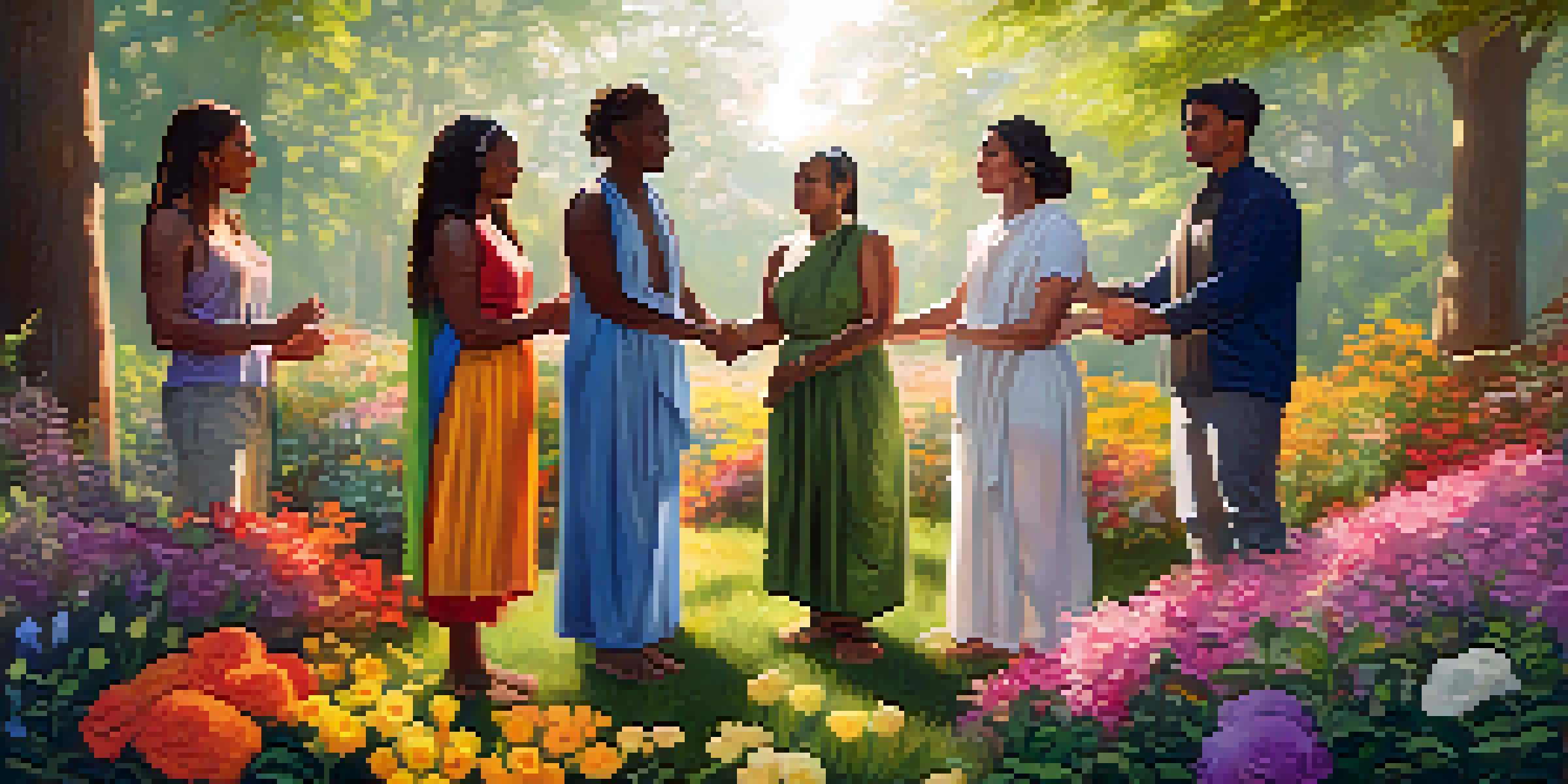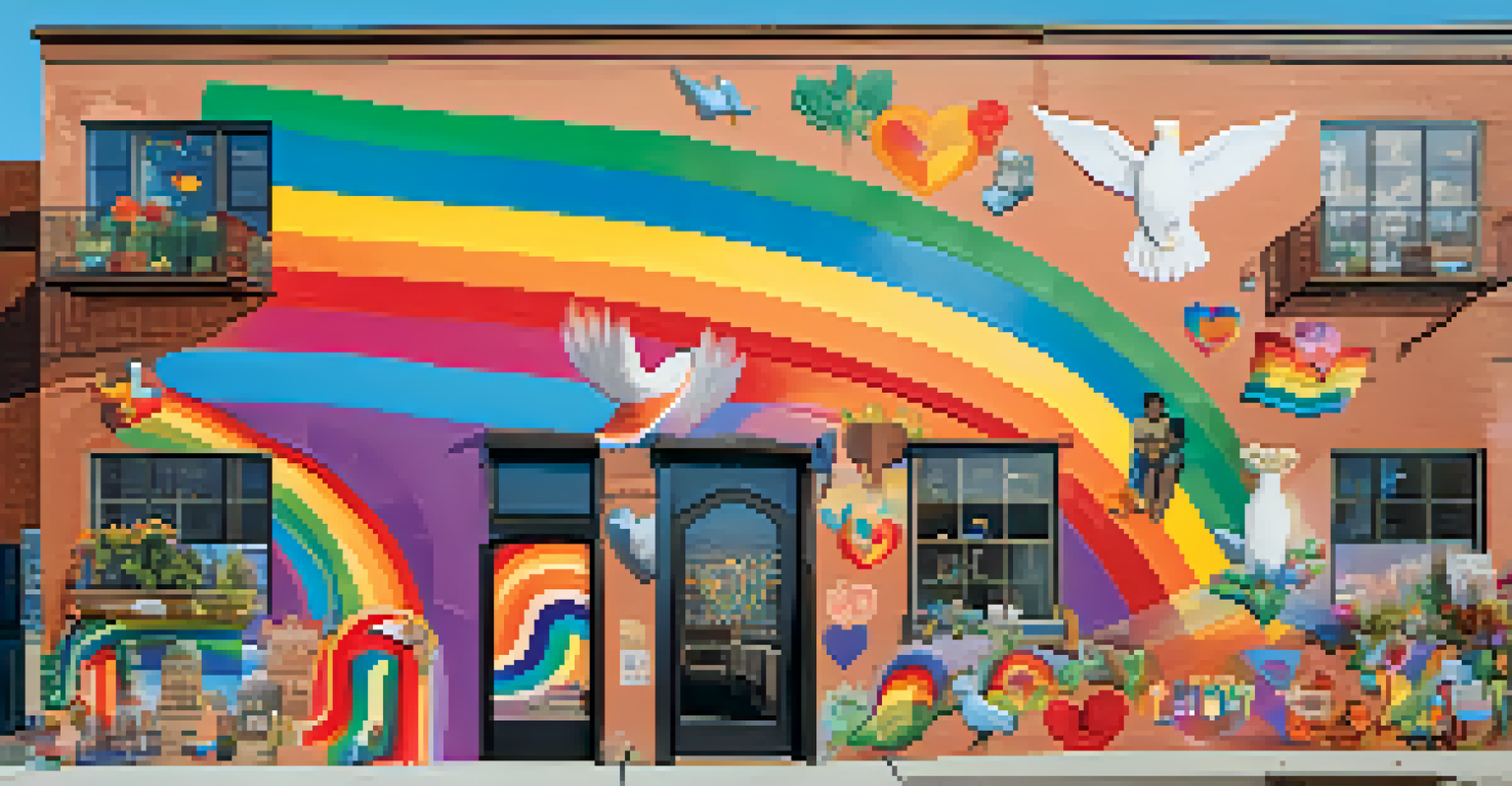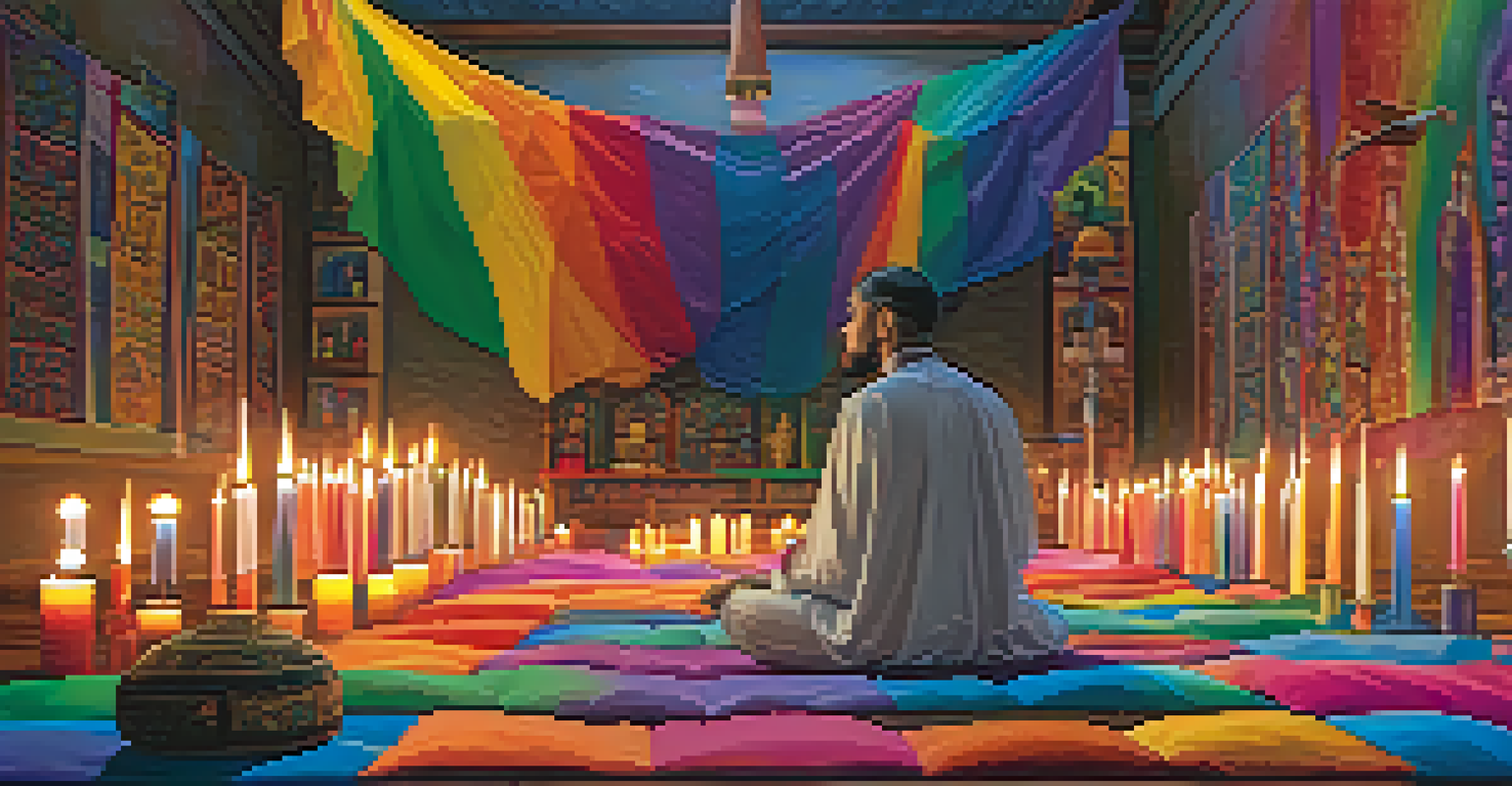The Influence of LGBTQ+ Identities on Spiritual Expression

Understanding Spiritual Expression in LGBTQ+ Contexts
Spiritual expression is a deeply personal journey for many, and it varies widely among individuals. For LGBTQ+ individuals, this journey often intertwines with their identities, creating unique pathways to spirituality. Many find that their sexual orientation or gender identity enriches their spiritual experiences, adding layers of meaning and authenticity.
Spirituality is not about being good, but about being real.
This blending of identity and spirituality can manifest in various ways, from participation in inclusive religious communities to personal practices that embrace LGBTQ+ narratives. For some, spirituality becomes a safe space where they can explore their true selves without fear of judgment. This exploration often leads to deeper connections with both the self and the divine.
Moreover, LGBTQ+ individuals may draw on their experiences of marginalization to develop a more profound understanding of concepts like compassion, acceptance, and love. These values often resonate deeply within spiritual traditions, allowing for an enriching dialogue between identity and belief.
Historical Context of LGBTQ+ Spirituality
To appreciate the current landscape of LGBTQ+ spirituality, it's essential to understand its historical context. Throughout history, many LGBTQ+ individuals have faced exclusion or persecution in traditional religious settings. This history of discrimination has led to the formation of alternative spiritual communities that celebrate diversity and inclusivity.

For example, the rise of LGBTQ+ affirming churches and spiritual organizations in the late 20th century marked a significant shift. These communities provided a refuge for those seeking spiritual connection while also embracing their identities. They fostered an environment where love and acceptance were paramount, countering the narratives of rejection that many had experienced.
Spirituality and LGBTQ+ Identity
LGBTQ+ individuals often find that their sexual orientation or gender identity enriches their spiritual experiences, creating authentic pathways to spirituality.
This historical evolution highlights the resilience of LGBTQ+ individuals in seeking spiritual fulfillment. It also underscores the importance of creating spaces where everyone can feel welcomed and valued, regardless of their sexual orientation or gender identity.
The Role of Rituals in LGBTQ+ Spiritual Practices
Rituals hold significant importance in spiritual practices, offering a sense of structure and meaning. For LGBTQ+ individuals, these rituals often incorporate elements that resonate with their identities, making spirituality feel more personal and authentic. Whether it’s a coming-out ceremony or a wedding that reflects their true selves, rituals can be powerful expressions of identity.
Love is not about who you are, but about who you are with.
Many LGBTQ+ communities have developed their own rituals that celebrate love, acceptance, and community. These practices not only affirm individual identities but also strengthen communal bonds. By participating in shared rituals, LGBTQ+ individuals find a sense of belonging and connection that can be profoundly healing.
Furthermore, these rituals can serve as acts of resistance against societal norms that often marginalize LGBTQ+ identities. In this way, spiritual expression becomes a reclaiming of power, allowing individuals to assert their place within both their communities and the larger spiritual landscape.
The Intersection of LGBTQ+ Identities and Faith Traditions
Many LGBTQ+ individuals navigate the complexities of aligning their sexual orientation or gender identity with traditional faith beliefs. This intersection can create tension, but it can also lead to transformative experiences. Some find solace in reinterpretations of sacred texts that affirm their identities, fostering a sense of belonging in their faith communities.
For instance, LGBTQ+ theologians have contributed significantly to discussions around faith and sexuality, offering fresh perspectives that challenge conventional views. Their work encourages both acceptance and understanding within faith traditions, paving the way for more inclusive practices. As these dialogues unfold, it becomes increasingly clear that spirituality can be expansive enough to encompass diverse identities.
Historical Exclusion and Resilience
The historical exclusion of LGBTQ+ individuals from traditional religious settings has led to the formation of inclusive spiritual communities that celebrate diversity.
Ultimately, the intersection of LGBTQ+ identities and faith traditions illustrates the evolving nature of spirituality. It highlights the potential for growth, understanding, and acceptance within religious frameworks, encouraging both communities and individuals to embrace a more inclusive approach.
Art and Expression in LGBTQ+ Spirituality
Artistic expression is a vital component of spiritual practice, especially within LGBTQ+ communities. From visual arts to music and performance, creative outlets allow individuals to explore and express their spiritual journeys. This artistic exploration often reflects personal experiences and identities, providing a powerful medium for storytelling and connection.
For many LGBTQ+ individuals, art serves as a form of healing and liberation. It creates spaces for vulnerability, allowing them to share their narratives and challenge societal norms. Furthermore, art can also bring communities together, fostering solidarity and shared understanding through collective experiences and expressions.
The intersection of art and spirituality provides a rich tapestry of expression that resonates deeply within LGBTQ+ communities. It's a reminder that spirituality is not just about belief but also about creativity, connection, and the celebration of diverse identities.
Challenges Faced by LGBTQ+ Individuals in Spiritual Spaces
Despite the progress made in many spiritual communities, LGBTQ+ individuals often face significant challenges. Many still encounter discrimination, exclusion, or lack of understanding in traditional religious settings. This can lead to feelings of isolation and alienation, hindering their ability to fully embrace their spiritual identities.
Moreover, the internal conflict between one’s sexual orientation or gender identity and religious beliefs can be a source of profound struggle. Some individuals may grapple with guilt or shame, stemming from teachings that condemn their identities. These challenges can create a barrier to spiritual fulfillment, making the journey toward acceptance more difficult.
Art as Spiritual Expression
Artistic expression serves as a vital outlet for LGBTQ+ individuals, allowing them to explore and share their spiritual journeys while fostering connection and healing within communities.
Addressing these challenges requires ongoing dialogue and education within spiritual communities. By fostering understanding and promoting inclusivity, these spaces can become more welcoming for LGBTQ+ individuals, allowing them to explore their spirituality without fear or hesitation.
The Future of LGBTQ+ Spiritual Expression
As society continues to evolve, so too does the landscape of LGBTQ+ spirituality. The growing recognition of diverse identities is paving the way for more inclusive spiritual practices and communities. This shift signals a promising future where individuals can express their identities freely within their spiritual journeys.
Emerging spiritual movements that prioritize inclusivity and acceptance are gaining traction, creating spaces for LGBTQ+ individuals to thrive. These movements challenge traditional notions of spirituality, emphasizing love, compassion, and authenticity over rigid dogma. As more communities embrace these values, the possibilities for spiritual expression become increasingly expansive.

Ultimately, the future of LGBTQ+ spiritual expression holds the potential for deep connection, healing, and transformation. By honoring diverse identities and fostering acceptance, spiritual communities can create a vibrant tapestry of beliefs that enrich all members, regardless of their backgrounds.